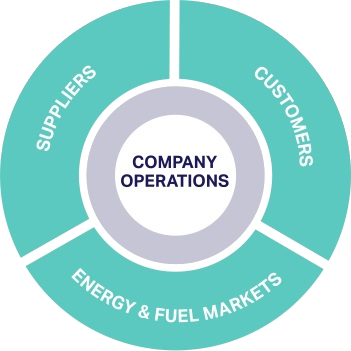GUIDELINES FOR AN INTEGRATED ENERGY STRATEGY
Helping companies achieve their sustainable energy objectives
What is an integrated energy strategy?
An integrated energy strategy covers all the energy your company uses for its operations and across its energy-related value chain. It describes how your company works cross-functionally internally and with upstream and downstream stakeholders externally. It defines how all energy-related inputs and outputs become more efficient, more circular and low-carbon. It acts as a roadmap to take your company from being a passive energy user to a proactive player.
An integrated energy strategy should be developed and implemented in alignment with your overall business strategy, anticipating and managing feedback loops between the two. This is particularly important for companies who are revising their business strategy to manage climate-related risks.
Developing and implementing an integrated low-carbon energy strategy is challenging. It requires involving a broad range of internal and external stakeholders, understanding fast evolving and complex energy markets, and the evaluation of new technologies and new energy sources using multifaceted decision criteria.
It’s also important to consider how your energy strategy interacts with your over-arching sustainability strategy and broader societal frameworks such as the United Nations Sustainable Development Goals (SDGs). An integrated energy strategy presents a range of opportunities to contribute towards achieving the SDGs. Direct contributions to SDGs 7 (affordable and clean energy) and 13 (climate action) are clear, but these efforts also have the potential to support the achievement of a wide range of other SDGs, such as SDG 11 (sustainable cities and communities) and SDG 12 (responsible consumption and production) to name but two.
Companies should also be mindful of any potential negative impacts on the global sustainable development agenda that could arise as consequences of their integrated energy strategy. It’s important to develop a clear picture of any potential risks to people or the environment ahead of implementation and to ensure that measures are in place to prevent or mitigate negative impacts.
These guidelines explain the six elements that are vital for an effective integrated energy strategy:
| Vision and targets |
Energy strategy governance |
Data collection and management |
| A vision that is supported by credible targets provides context, direction and commitments. | A strong governance framework clearly defines accountabilities throughout the company and ensures continuing commitment from executive management. | A robust data management program allows energy and emissions data to be analyzed with confidence. |
| Mandatory and voluntary reporting |
Internal and external engagement |
Solutions |
| external and internal reporting aids action-oriented insight, maintains momentum, and identifies improvements areas for the energy strategy. | An effective plan to engage with internal and external stakeholders enables prioritization of efforts, accelerates progress and can be critical to securing buy-in and achieving strategic goals. | A roadmap of measures that improve energy efficiency and increase the use of low-carbon energy and fuel – in your operations and together with your value chain. It ensures that highest impact measures are acted on first and strategy implementation is coordinated with other business priorities. |
Who should read these guidelines?
These guidelines are designed for employees involved in developing the company’s integrated energy strategy, encompassing different positions in senior management, strategic sourcing/procurement, manufacturing, engineering, energy, sustainability and corporate strategy. The guidelines help different functions understand an integrated energy strategy’s:
- business benefits and new opportunities
- value of harnessing collaboration with upstream and downstream stakeholders
- key elements and processes

Copyright © 2025
World Business Council for Sustainable Development
All rights reserved | Privacy Policy

